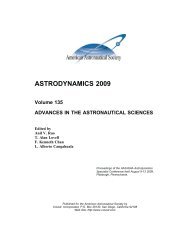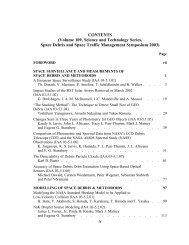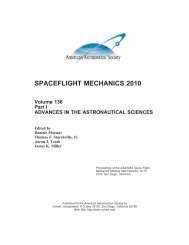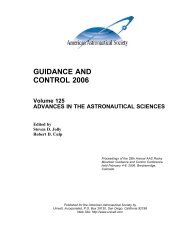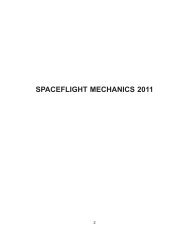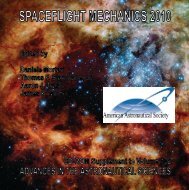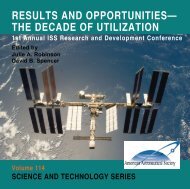information. - Univelt
information. - Univelt
information. - Univelt
- No tags were found...
You also want an ePaper? Increase the reach of your titles
YUMPU automatically turns print PDFs into web optimized ePapers that Google loves.
AAS 12-045SAFEHOLD ATTITUDE DETERMINATION APPROACH FOR GPMHenry Fitzpatrick * and Keith DeWeese *Spacecraft safing designs generally have minimal goals with loose pointing requirements.Safe pointing orientations for three-axis stabilized spacecraft are usuallychosen to put the spacecraft into a thermally safe and power-positive orientation. In addition,safe mode designs are required to be simple and reliable. This simplicity lendsitself to the usage of analog sun sensors, because digital sun sensors will add unwantedcomplexity to the safe hold mode.The Global Precipitation Measurement (GPM) Mission Core Observatory willlaunch into lower earth orbit (LEO) at an inclination of 65 degrees. The GPM instrumentsuite consists of an active radar system and a passive microwave imager to providethe next-generation global observations of rain and snow. The complexity and precisionof these instruments along with the operational constraints of the mission resultin tight pointing requirements during all phases of the mission. To ensure the instrumentsare not damaged during spacecraft safing, thermal constraints dictate that the solarpointing orientation must be maintained to better than 6.5 degrees. This requirementis outside the capabilities of a typical analog sun sensor suite, primarily due to the effectsof Earth’s albedo. To ensure mission success, a new analog sensor, along with theappropriate algorithms, is needed.This paper discusses the design issues involving albedo effects on spacecraft pointingand the development of a simple, low-cost analog sensor and algorithm that will addressthe needs of the GPM mission. In addition, the algorithms are designed to be easilyintegrated into the existing attitude determination software by using common interfaces.The sensor design is based on a heritage, commercial off-the-shelf analog sunsensors with a limited field-of-view to reduce the effects of Earth’s albedo. High fidelitysimulation results are presented that demonstrate the efficacy of the design.[View Full Paper]* Aerospace Engineer, NASA/Goddard Space Flight Center, Code 591, Greenbelt, Maryland 20771, U.S.A.21



